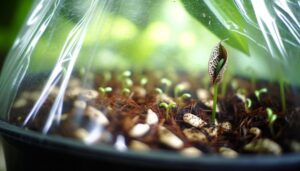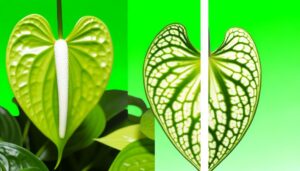What Makes Anthurium King Clarinervium Unique? Discover!
Anthurium King Clarinervium is unique due to its striking leaf patterns, featuring intricate veining on dark green foliage, which enhances photosynthetic efficiency. The velvety texture of its leaves, resulting from specialized trichomes, minimizes water loss and adds a distinctive sheen.
Its heart-shaped leaves with prominent silvery-white veins optimize nutrient and water transport. Additionally, the plant effectively filters indoor pollutants such as formaldehyde and benzene, improving air quality.
Its resilience in various conditions, combined with manageable care requirements, makes it highly desirable among plant collectors. To understand more about its unique aspects and care needs, the following information offers detailed insights.
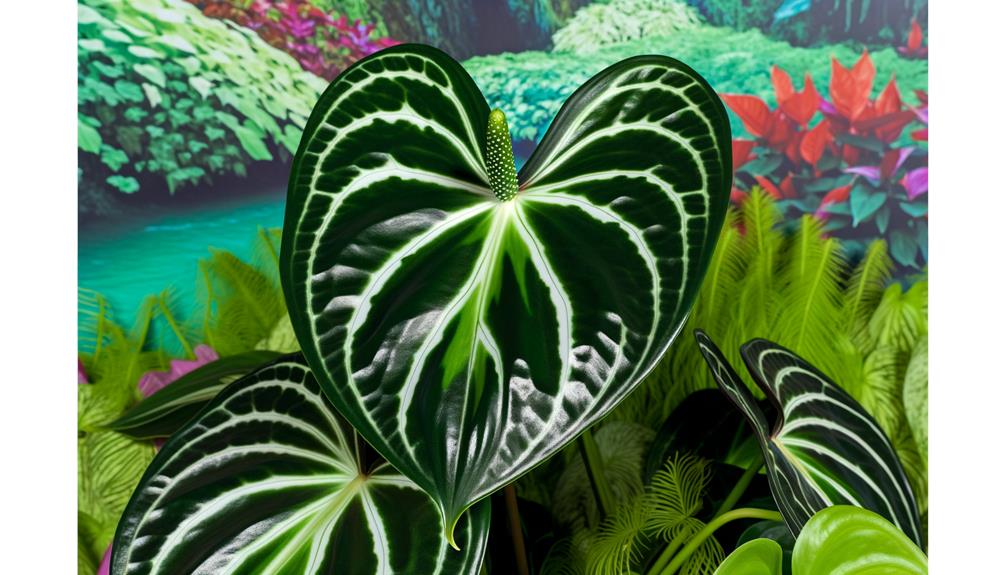
Key Takeaways
- Intricate veining on dark green leaves enhances nutrient transport and photosynthetic activity.
- Luxurious, velvety leaf surface reduces water loss and improves drought resistance.
- Heart-shaped leaves with prominent venation optimize photosynthetic efficiency.
- Effective air purifier filtering out formaldehyde and benzene, improving indoor air quality.
- Thrives in bright, indirect sunlight with high humidity, making it popular and manageable for collectors.
Striking Leaf Patterns
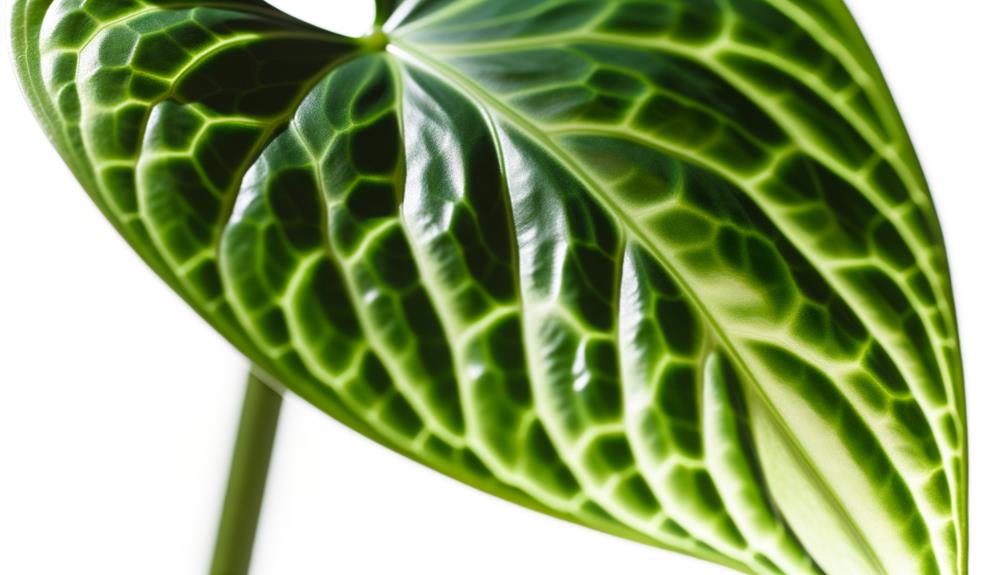
The Anthurium King Clarinervium is renowned for its striking leaf patterns, characterized by prominent, intricate veining that contrasts vividly against the velvety dark green foliage.
Each leaf features a complex network of white veins that create a visually arresting mosaic, enhancing the plant’s ornamental value.
The veining pattern is not merely superficial; it plays a critical role in the physiological processes, including nutrient transport and structural support.
The pronounced veining is a result of selective breeding, emphasizing both aesthetic appeal and functional efficiency. This unique leaf morphology allows for optimal photosynthetic activity, contributing to the plant’s vigorous growth.
The juxtaposition of the dark green leaf surface with the white veins provides a dramatic visual effect, making it a favored choice among horticulturists.
Velvety Texture
The Anthurium King Clarinervium is distinguished by its luxurious leaf surface, characterized by a velvety texture that enhances its visual and tactile appeal.
This unique texture results from microscopic structures on the leaf epidermis, contributing to a soft touch that is both inviting and sophisticated.
Analyzing the interplay between these structures and light reveals how they create the plant’s characteristic sheen, adding to its ornamental value.
Luxurious Leaf Surface
Exhibiting a remarkable velvety texture, the leaf surface of Anthurium King Clarinervium is a quintessential example of specialized epidermal cell adaptations.
The surface is characterized by a unique arrangement of trichomes, which are microscopic hair-like structures, that contribute to its distinctively soft and luxurious feel.
These trichomes play a critical role in reducing water loss by trapping moisture and reflecting excess sunlight, thereby enhancing the plant’s drought resistance.
Additionally, the velvety texture results from a complex interplay of cuticular waxes and cell wall compositions that create a matte finish, minimizing light reflection and maximizing the efficiency of photosynthesis.
Such detailed morphological features underscore the adaptive evolutionary strategies that confer ecological advantages to this striking tropical species.
Soft Touch Appeal
Characterized by its velvety texture, the Anthurium King Clarinervium offers a tactile experience that complements its visual appeal, resulting from an intricate structure of epidermal cells and specialized trichomes.
These trichomes, minute hair-like projections on the leaf surface, enhance the plant’s ability to retain moisture and protect against pathogens.
The velvety feel is a result of a dense, uniform layer of these trichomes, which scatter light, contributing to the leaf’s unique sheen.
Additionally, this texture minimizes water loss through transpiration, optimizing the plant’s water-use efficiency.
Such physiological adaptations not only elevate the sensory experience but also contribute to the plant’s overall resilience, making it a distinctive and appealing addition to both private collections and botanical displays.
Heart-Shaped Leaves

Frequently admired for their distinct morphology, Anthurium King Clarinervium‘s heart-shaped leaves feature prominent venation and a lush, velvety texture that exemplifies botanical elegance.
The leaves exhibit a coriaceous, or leathery, quality, enhancing their durability and aesthetic appeal. Characterized by their dark green hue, the leaves contrast strikingly with the pronounced, silvery-white veins that traverse their surface, creating a visually enchanting network.
These veins not only contribute to the leaf’s ornamental value but also play a critical role in the plant’s vascular system, facilitating efficient nutrient and water transport. The broad, cordate shape optimizes photosynthetic efficiency, allowing for maximal light absorption.
These intricate features collectively underscore the unique allure of Anthurium King Clarinervium within the Aroid family.
Easy Care Routine
Anthurium King Clarinervium thrives under specific light and water conditions, necessitating bright, indirect sunlight and consistent moisture without waterlogging.
The best soil mix comprises a well-draining, aerated substrate rich in organic matter to support root health.
Maintaining ambient humidity levels around 60-80% is essential for best growth and foliage health.
Light and Water Needs
To maximize growth and health, the Anthurium King Clarinervium requires bright, indirect light and a carefully balanced watering regimen that maintains consistent soil moisture without causing waterlogging.
This species thrives under filtered sunlight, mimicking its natural understory habitat, where it receives dappled light. Direct sunlight can scorch its leaves, while insufficient light leads to leggy growth and diminished vigor.
Watering should be conducted when the top inch of soil feels dry to touch. Overwatering, or allowing the plant to stand in water, can lead to root rot and other pathogenic issues.
Conversely, prolonged drought stress can cause leaf browning and reduced physiological function. Utilizing room-temperature, filtered water minimizes potential chemical stress on the plant.
Ideal Soil Mix
Maintaining ideal soil conditions is equally important as light and water management for the Anthurium King Clarinervium. It requires a well-draining, aerated substrate that replicates the plant’s epiphytic natural habitat.
A soil mix with large particles to promote proper aeration, like orchid bark, perlite, and activated charcoal, is essential. These components aid in oxygenation and prevent root rot by supporting efficient drainage.
Furthermore, including peat moss or coco coir improves moisture retention while balancing air and water levels.
This composite mixture guarantees that the roots receive sufficient nutrients and moisture without becoming waterlogged, hence mimicking the conditions of a tropical rainforest canopy. Regular monitoring and adjustment of the soil mix can further enhance plant health and growth.
Humidity Requirements
Perfect moisture levels are vital for the Anthurium King Clarinervium, necessitating a steady environment with relative moisture between 60% and 80% to mirror its native tropical rainforest conditions.
This species thrives in high-moisture settings, essential for preserving its striking foliage. Insufficient moisture can result in adverse effects such as browning leaf edges and stunted growth.
To achieve best moisture levels, consider the following methods:
- Humidifiers: Utilize a humidifier to uphold the recommended moisture range consistently.
- Misting: Regular misting with distilled water can offer short-term moisture boosts.
- Moisture Trays: Place the plant on a moisture tray filled with water and pebbles to create a localized moist microenvironment.
Incorporating these practices guarantees the Anthurium King Clarinervium remains vibrant and healthy.
Resilience and Durability
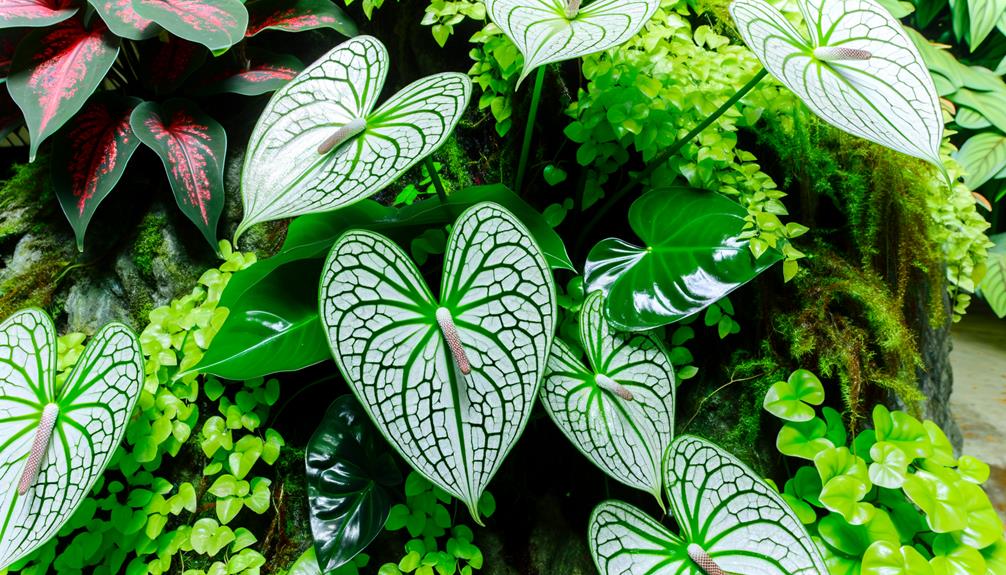
The resilience and durability of Anthurium King Clarinervium are primarily attributed to its robust cellular structure and adaptive physiological mechanisms.
The plant’s thick, leathery leaves are composed of specialized cells that minimize water loss, enhancing its drought tolerance.
In addition, its root system exhibits a high degree of plasticity, allowing it to efficiently absorb nutrients and water from varying soil conditions. The waxy cuticle layer on the leaves acts as a barrier against pathogens and physical damage.
Moreover, the plant’s ability to adjust its photosynthetic activity based on light availability contributes to its survival in diverse environments.
These intrinsic properties collectively confer Anthurium King Clarinervium with an exceptional capacity to withstand environmental stressors, making it a hardy and enduring species.
Air Purifying Qualities
Anthurium King Clarinervium greatly contributes to indoor air quality by absorbing volatile organic compounds (VOCs) through its extensive leaf surface area.
This plant’s large, velvety leaves contain numerous stomata, which facilitate gas exchange and the absorption of harmful substances.
The plant’s air-purifying qualities are particularly effective in mitigating indoor pollution, thereby enhancing respiratory health.
Key benefits include:
- Reduction of VOCs: Anthurium King Clarinervium excels at filtering out chemicals like formaldehyde and benzene.
- Enhanced Oxygen Levels: The photosynthetic process increases ambient oxygen, contributing to a fresher indoor environment.
- Humidity Regulation: The plant releases moisture through transpiration, aiding in maintaining ideal indoor humidity levels.
These attributes make Anthurium King Clarinervium an invaluable component of healthy indoor ecosystems.
Ideal Growing Conditions
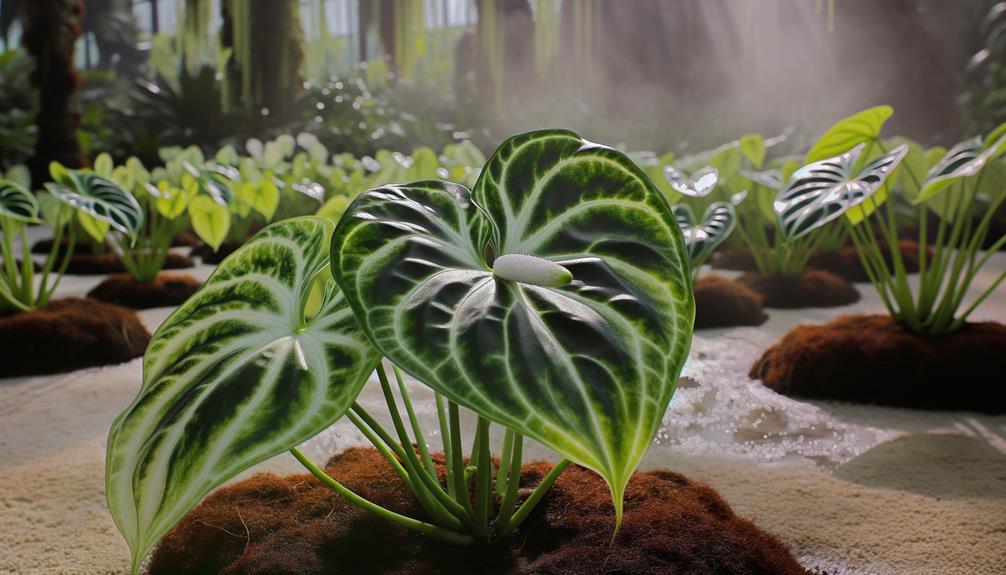
To fully capitalize on the air-purifying benefits of Anthurium King Clarinervium, it is vital to understand the optimum environmental conditions required for its growth.
This species thrives in well-draining, airy substrates rich in organic matter, such as a mix of orchid bark, perlite, and peat moss.
Ideal temperature ranges between 18°C to 25°C (64°F to 77°F), avoiding cold drafts and direct sunlight. Humidity levels should be consistently high, around 60-80%, necessitating frequent misting or the use of a humidifier.
Indirect, bright light is essential; insufficient light will stunt growth, while direct sunlight may cause leaf burn. Ensuring these precise parameters will foster robust plant health and maximize its air-purifying efficiency.
Popularity Among Collectors
Renowned for its striking foliage and intricate venation, King Clarinervium has garnered significant acclaim among botanical enthusiasts and plant collectors.
This species’ unique visual features and relatively manageable care requirements contribute to its esteemed status.
Collectors are particularly drawn to its velvety, heart-shaped leaves, which display pronounced white veins against a deep green backdrop.
Limited availability in nurseries heightens its desirability. The plant’s dramatic foliage serves as a focal point in any collection. Its adaptability to indoor environments makes it a practical choice for urban dwellers.
The combination of these characteristics guarantees that King Clarinervium remains a coveted specimen, appealing to both novice hobbyists and seasoned collectors alike.
Anthurium King Clarinervium Vs Clarinervium
| Feature | Anthurium King Clarinervium | Clarinervium |
|---|---|---|
| Size | Larger leaves | Smaller leaves |
| Growth Rate | Faster growth | Slower growth |
| Leaf Texture | More pronounced velvety texture | Velvety texture |
| Vein Pattern | More intricate vein patterns | Prominent veins, less intricate |
| Care Level | Requires more attention | Easier to manage |
| Watering Needs | More frequent | Less frequent |
| Fertilizing Needs | More frequent | Less frequent |
| Appearance | Robust, pronounced features | Delicate, less pronounced features |
Conclusion
To sum up, the Anthurium king clarinervium, known for its striking leaf patterns, velvety texture, and heart-shaped morphology, stands out as a botanical marvel.
Its ability to withstand challenges, along with its simple care needs, highlights its strength.
The plant’s exceptional air-purifying qualities and ability to thrive in optimal growing conditions also enhance its appeal.
It is no wonder that this plant has captured the attention of collectors globally, solidifying its position as the ultimate ornamental foliage gem.

